Text


219) Megapodius layardi; Nogal żółtonogi, Vanuatu megapode, Vanuatu scrubfowl, New Hebrides scrubfowl - gatunek ptaka z rodziny Megapodiidae. Występuje tylko w Vanuatu. Jego naturalnym siedliskiem jest subtropikalny lub tropikalny wilgotny las nizinny. Gatunek ten jest zagrożony utratą siedlisk i zbieraniem jaj.
Dwa syntypowe okazy Megapodius layardi znajdują się w zbiorach National Museums Liverpool w World Museum, z numerami identyfikacyjnymi T9758 (dorosły samiec) i T9759 (dorosła samica). Okazy zostały zebrane na wyspie Vate (Efate) odpowiednio w lipcu i wrześniu 1877 r. przez Edgara Leopolda Layarda i trafiły do kolekcji narodowej w Liverpoolu za pośrednictwem kolekcji kanonika Henry’ego Bakera Tristrama, kt��ra została zakupiona w 1896. W kolekcji ptaków w Muzeum Historii Naturalnej w Tring znajdują się trzy kolejne syntypy. Nie wyróżnia się podgatunków. Takson ten bywał niekiedy uznawany za podgatunek nogala ciemnego (M. freycinet).
Nogal żółtonogi jest endemitem Vanuatu. Występuje na większości wysp w północnej i środkowej części tego wyspiarskiego państwa, aż po Efate na południu. Nie jest znany status gatunku na wyspie Tanna w południowej części Vanuatu – albo wymarł, albo nigdy tam nie występował.
Gatunek ten występuje do wysokości około 800 m n.p.m. Jego głównym naturalnym siedliskiem są subtropikalne lub tropikalne wilgotne lasy nizinne i zarośla. Bywał też niekiedy spotykany w ogrodach i lasach zdegradowanych. Żyje na ziemi; w przypadku zagrożenia woli uciec biegiem niż odfrunąć. Prawdopodobnie sezon lęgowy trwa cały rok, ale głównie od czerwca do sierpnia. Lęgnie się w norach, być może buduje też kopce, ale nie ma na to dowodów. Inkubacja jaj trwa około 45 dni. Zjada owady, larwy, robaki, ślimaki i inne bezkręgowce; także owoce, nasiona itp. Rozgrzebuje wilgotną ściółkę w poszukiwaniu jedzenia.
W Czerwonej księdze gatunków zagrożonych IUCN, nogal żółtonogi jest klasyfikowany jako gatunek narażony na wyginięcie (VU, Vulnerable). Liczebność populacji szacowana jest na 2500–9999 dorosłych osobników. Trend populacji uznawany jest za spadkowy, z powodu zagrożeń związanych ze zmniejszaniem się habitatu.
0 notes
Text
Megapodius

Orange-Footed Scrubfowl, M. reinwardt, by Bernard Dupont, CC BY-SA 2.0
PLEASE SUPPORT US ON PATREON. EACH and EVERY DONATION helps to keep this blog running! Any amount, even ONE DOLLAR is APPRECIATED! IF YOU ENJOY THIS CONTENT, please CONSIDER DONATING!
Name: Megapodius
Status: Extant
First Described: 1823
Described By: Gaimard
Classification: Dinosauria, Saurischia, Eusaurischia, Theropoda, Neotheropoda, Averostra, Tetanurae, Orionides, Avetheropoda, Coelurosauria, Tyrannoraptora, Maniraptoriformes, Maniraptora, Pennaraptora, Paraves, Eumaniraptora, Averaptora, Avialae, Euavialae, Avebrevicauda, Pygostylia, Ornithothoraces, Euornithes, Ornithuromorpha, Ornithurae, Neornithes, Neognathae, Galloanserae, Pangalliformes, Galliformes, Megapodiidae
Referred Species: M. pritchardii (Tongan Megapode, Extant), M. laperouse (Micronesian Megapode, Extant), M. nicobariensis (Nicobar Megapode, Extant), M. cumingii (Philippine Megapode, Extant), M. bernsteinii (Sula Megapode, Extant), M. tenimberensis (Tanimbar Megapode, Extant), M. freycinet (Dusky Megapode, Extant), M. geelvinkianus (Biak Scrubfowl, Extant), M. eremita (Melanesian Megapode, Extant), M. layardi (Vanuatu Megapode, Extant), M. affinis (New Guinea Scrubfowl, Extant), M. reinwardt (Orange-Footed Scrubfowl, Extant), M. molistructor (Pile-Builder Scrubfowl, Extinct), M. amissus (Viti Levu Scrubfowl, Extinct)

Micronesian Megapode, M. laperouse, by Michael Lusk, CC BY-SA 2.0
Megapodius is, by far, the largest genus of Megapodes, with many species making up its genus. Most of these species are alive today, though there are two distinct extinct ones as well. These birds are commonly called Scrubfowl, and, like all Megapodes, are distinctly unique due to their highly specialized method of egg incubation. M. molistructor, the Pile-Builder Megapode, is an extinct species from New Caledonia and Tonga, known from only about 12,000 years ago on, in the Holocene of the Quaternary. Weighing about 3.5 kilograms, it was the heaviest species in this genus, and one of the largest ground-dwelling birds of the islands it lived on. This bird probably went extinct due to the arrival of human settlers about 3500 years ago. The other extinct Speices, M. amissus, the Viti Levu Scrubfowl, was a Megapode known from Fiji during the Holocene, about the size of the Orange-Footed Scrubfowl, though with more robust legs and reduced wings, indicating flightlessness. It, too, went extinct due to overhunting and other human activity.
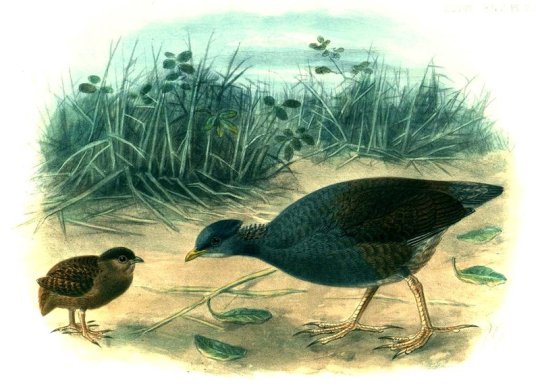
Tongan Megapode, M. pritchardii, by Walter Lawry Buller, in the Public Domain
The Tongan Megapode is an endangered species known from Tonga, the only remaining species of Megapode still known from these islands, even though multiple species were present prior to the arrival of humans. Their remote habitat made populations of these birds vulnerable to human activity. They live primarily in tropical lowland forests, and they use the warm volcanic soil of their habitats to incubate their eggs. The baby birds are able to fly immediately upon hatching. These birds are threatened due to human hunting and habitat reduction.
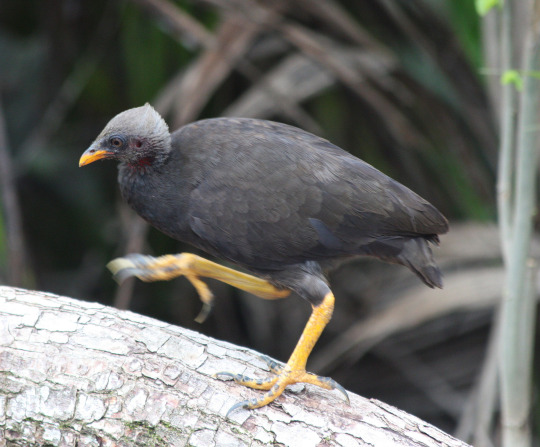
Micronesian Megapode, M. laperouse, by Michael Lusk, CC BY-SA 2.0
The Micronesian Megapode is another endangered species, about 38 centimeters in length, from the Marianas Islands. Medium-sized birds, they have pale heads, dark bodies, and bright yellow legs. They are usually found in thickets and lowland scrub, and they’re very shy and secretive. They breed after the monsoon season and make large mounds of debris to lay their eggs, sometimes multiple females using the same mound. They are protected, but the introduction of mammalian predators have greatly reduced their populations.
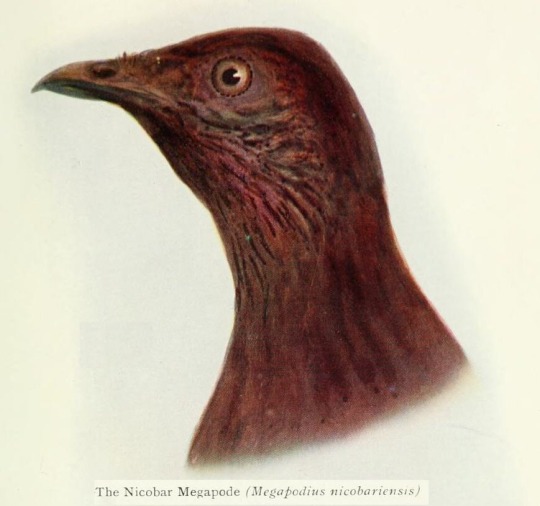
Nicobar Megapode, M. nicobariensis, by R. W. Shufeldt, in the Public Domain
The Nicobar Megapode is a vulnerable species known from the Nicobar Islands of India. It builds large nest mounds, like the other species in this genus; but are very secretive in how they do so - they primarily build mounds near the coast with coral sand and plant material, and the mounds are often reused. The young birds are fully feathered, and can fly as soon as their feathers dry up. They mainly move around in thick jungle during the day, and go out onto the shore of the ocean at night, mainly walking in small groups or pairs. They eat both plant and animal material, ingesting grit to aid in digestion. They are brownish birds, and are primarily threatened due to habitat loss and human activity.
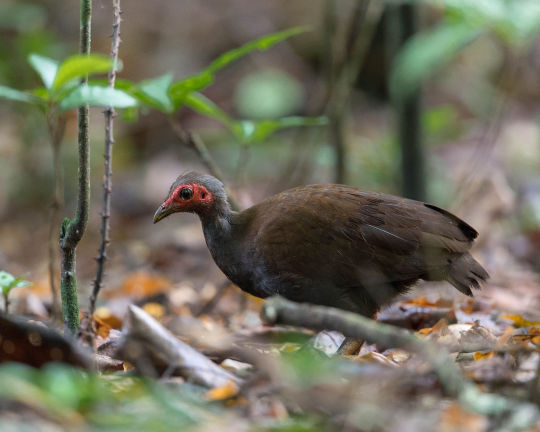
Philippine Megapode, M. cumingii, by Jason Thompson, CC BY 2.0
The Philippine Megapode, which is such a little cutie, is a non-threatened species found in the Philippines, Borneo, and Sulawesi, mainly in dry forest, moist lowland forest, and mountain forests.
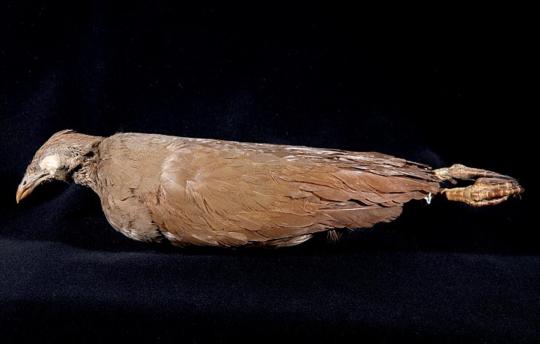
Sula Megapode, M. bernsteinii, by Huub Veldhuijzen van Zanten, CC BY-SA 3.0
The Sula Megapode, is a vulnerable species known on the Banggai and Sula Islands in Indonesia, primarily in tropical and subtropical forest, both dry and wet, as well as mangrove forests. As such, it is extensively threatened with habitat destruction. These birds are reddish brown, with short pointed crests, and they grow up to 35 centimeters in length. They forage in pairs, or sometimes small groups, mainly on roots and invertebrates. They perform mating dances, to an extent, where all the birds call out together, and then build cone-shape mounds over rotting vegetation to keep the eggs warm. The Tanimbar Megapode, M. tenimberensis, on the other hand, is a near-threatened species from the Tanimbar Islands of Indonesia, about the size of a domestic chicken. It’s primarily found in forest and scrubland, and feeds on fallen fruit, seeds, and invertebrates.

Dusky Megapode, M. freycinet, by Nicolas Huet, in the Public Domain
The Dusky Megapode, is a 41 centimeters long black bird with a short pointed crest and red facial skin. They look similar across the sexes, and build mounds made of leaves, sand, gravel, and sticks, as large as 11 meters in diameter. They are very common birds and not considered currently threatened with extinction.
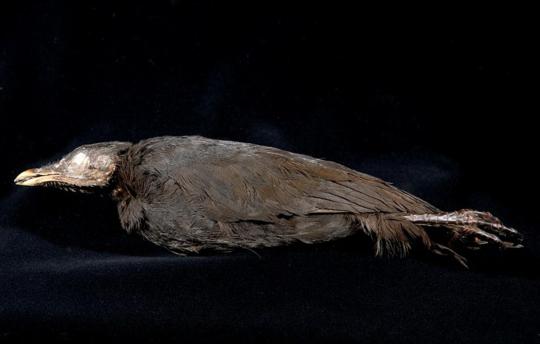
Biak Scrubfowl, M. geelvinkianus, by Huub Veldhuijzen van Zanten, CC BY-SA 3.0
The Biak Scrubfowl is a vulnerable species known from islands in West Papua, Indonesia, measuring about 36 centimeters in length, with dark grey feathers and a blueish face. They live in lowland tropical forests and some shrublands, which has lead to its threatened position due to habitat loss.
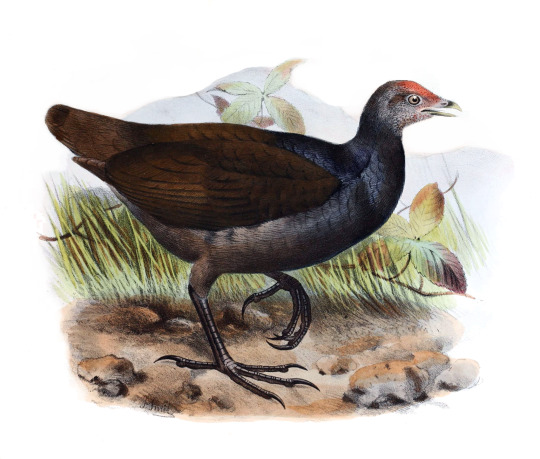
Melanesian Megapode, M. eremita, by Joseph Smit, in the Public Domain
The Melanesian Megapode is a nonthreatened scrubfowl species from Papua New Guinea and the Solomon Islands, living in tropical lowland forests and some mountain forests. It has brown and blue feathers, and a red patch on its head.

Vanuatu Megapode, M. layardi, by W. R. Ogilvie-Grant, in the Public Domain
The Vanuatu Megapode is a vulnerable species known from the island of Vanuatu, living in subtropical and tropical lowland forest. Unfortunately, it’s threatened by habitat loss and egg hunting. The New Guinea Scrubfowl, N. decollatus, on the other hands, is a poorly studied nonthreatened Megapode from tropical lowland forests and mountain forests in New Guinea, but unfortunately it isn’t very well documented.
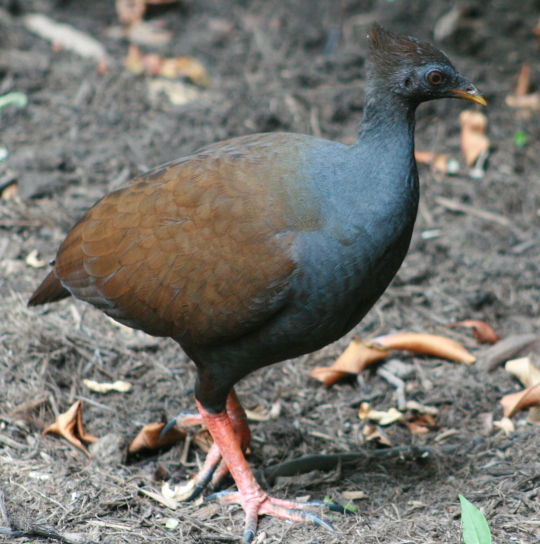
Orange-Footed Scrubfowl, M. reinwardt, by Toby Hudson, CC BY-SA 3.0
Finally, the Orange-Footed Scrubfowl is a non-threatened species from the Sunda Islands, New Guinea, and Australia. The size of a chicken, it has brown and blue feathers, with orange feet, hence its name. They also have distinctive pointy crests. They live in forest and scrubland habitat, and make mounds of sand and leaf litter that can reach up to 4.5 meters in height. They mainly eat seeds, fallen fruit, and some invertebrates.
Buy the author a coffee: http://ko-fi.com/kulindadromeus
Sources:
https://en.wikipedia.org/wiki/Scrubfowl
https://en.wikipedia.org/wiki/Pile-builder_megapode
https://en.wikipedia.org/wiki/Viti_Levu_scrubfowl
https://en.wikipedia.org/wiki/Tongan_megapode
https://en.wikipedia.org/wiki/Micronesian_megapode
https://en.wikipedia.org/wiki/Nicobar_megapode
https://en.wikipedia.org/wiki/Philippine_megapode
https://en.wikipedia.org/wiki/Sula_megapode
https://en.wikipedia.org/wiki/Tanimbar_megapode
https://en.wikipedia.org/wiki/Dusky_megapode
https://en.wikipedia.org/wiki/Biak_scrubfowl
https://en.wikipedia.org/wiki/Melanesian_megapode
https://en.wikipedia.org/wiki/Vanuatu_megapode
https://en.wikipedia.org/wiki/New_Guinea_scrubfowl
https://en.wikipedia.org/wiki/Orange-footed_scrubfowl
#megapodius#scrubfowl#megapode#dinosaur#chicken#pheasant#birblr#palaeoblr#megapodius pritchardii#tongan megapode#megapodius laperouse#micronesian megapode#megapodius nicobariensis#nicobar megapode#megapodius cumingii#philippine megapode#megapodius bernsteinii#sula megapode#megapodius tenimberensis#tanimbar megapode#megapodius freycinet#dusky megapode#megapodius geelvinkianus#biak scrubfowl#megapodius eremita#melanesian megapode#megapodius layardi#vanuatu megapode#megapodius affinis#new guinea scrubfowl
45 notes
·
View notes
Photo

News from the Pacific is that Rich Lindie, Erik Forsyth and their intrepid group of twelve have had a wonderfully successful time in New Caledonia and Vanuatu. Where, despite having to make due with one less day than usual (due to flight schedules), they have seen all but two of the possible endemics already. Obvious highlights include half an hour with two Kagu, and multiple sightings of Vanuatu Megapode – on top of being able to enjoy afternoon breaks at some of the nicest lodgings in the region. Oh, and a sighting of a Dugong!
The group heads to Fiji next, where another great list of endemics awaits – we look forward to hearing news about their sightings there too!
Photo – Kagu by Rich Lindie
#birds#birding#birdwatching#nature#wildlife#birdingtours#pacific#pacificislands#island#vanuatu#newcaledonia#photography#birdphotography#naturephotography#wildlifephotography#kagu
30 notes
·
View notes
Text

6 February 2019
Wednesday is ruled by Mercury.
Today is a good day to perform rituals involving Luck.
On this day in 1918 Great Britain granted women 30 and over the right to vote.
Fun Facts – coconut water can be used as blood plasma.
Today we will dedicate to Montgomery Palm and our backyard buddy Vanuatu Megapode.
I am grateful for waterfalls.
‘We met for a reason, either you are a blessing or a lesson.’
#365daysofwhy #astrology2019 #vote #coconutwater #blessing #lesson #waterfalls #coffee #chocolate
0 notes
Text
#Vanuatu
#Vanuatu #Vatthe #longlivempas #oceaneducation #Vanuatu #Aore #longlivempas #oceaneducation #Vanuatu #Ambrym Megapode Reserve Forest Conservation Area #longlivempas #oceaneducation #Vanuatu #Erakor and Empten Lagoon #longlivempas #oceaneducation #Vanuatu #President Coolidge and Million Dollar Point #longlivempas #oceaneducation #Vanuatu #Nguna Pele #longlivempas #oceaneducation #Vanuatu #Bucaro Aore #longlivempas #oceaneducation #Vanuatu #Ponkovio #longlivempas #oceaneducation #Vanuatu #Narong #longlivempas #oceaneducation #Vanuatu #Emua #longlivempas #oceaneducation #Vanuatu #Lekavik #longlivempas #oceaneducation #Vanuatu #Ringi te Extension #longlivempas #oceaneducation #Vanuatu #Nagha mo Pineia #longlivempas #oceaneducation #Vanuatu #Loru #longlivempas #oceaneducation #Vanuatu #Whitesands #longlivempas #oceaneducation #Vanuatu #Hiu Island #longlivempas #oceaneducation #Vanuatu #Ringi Te Suh #longlivempas #oceaneducation #Vanuatu #Naomebaravu-Malo #longlivempas #oceaneducation #Vanuatu #Vendik #longlivempas #oceaneducation #Vanuatu #Hideaway Island #longlivempas #oceaneducation #Vanuatu #Uri #longlivempas #oceaneducation
https://www.vectorstock.com/royalty-free-vector/black-white-vanuatu-outline-map-vector-950945

0 notes
Text
Mwalau walterlinii

By José Carlos Cortés on @quetzalcuetzpalin
PLEASE SUPPORT US ON PATREON. EACH and EVERY DONATION helps to keep this blog running! Any amount, even ONE DOLLAR is APPRECIATED! IF YOU ENJOY THIS CONTENT, please CONSIDER DONATING!
Name: Mwalau walterlinii
Status: Extinct
First Described: 2015
Described By: Worthy
Classification: Dinosauria, Saurischia, Eusaurischia, Theropoda, Neotheropoda, Averostra, Tetanurae, Orionides, Avetheropoda, Coelurosauria, Tyrannoraptora, Maniraptoriformes, Maniraptora, Pennaraptora, Paraves, Eumaniraptora, Averaptora, Avialae, Euavialae, Avebrevicauda, Pygostylia, Ornithothoraces, Euornithes, Ornithuromorpha, Ornithurae, Neornithes, Neognathae, Galloanserae, Pangalliformes, Galliformes, Megapodiidae
Mwalau is our first Megapode! Megapodes are a living group of chickeny dinosaurs known primarily from the Oceania region, and are unique amongst dinosaurs in being extremely solitary and not taking care of their young apart from laying eggs in specialized mounds and leaving them. The young then hatch, completely independent, and quickly able to fly - the only other group of dinosaurs that seem to showcase this sort of immediate independence are titanosaurs, so this really isn’t a usual thing for dinosaurs to do. Despite being a member of a living group, Mwalau is an extinct Megapode, dubbed Lini’s Megapode. It was found in the Teouma Site of Efate Island, Vanuatu, living very recently indeed, around 12,000 years ago until sometime within the Holocene of the Quaternary when human settlers probably lead to its extinction. Known from extensive fossil/subfossil material, it seems to be one of the largest megapodes known, larger than any living birds. It was probably able to fly, having strong chest muscles and delicate legs, so it might not have been as good of a mound builder as living Megapodes. This would make it a fairly unusual genus of Megapode, and one worth further study going forward.
Buy the author a coffee: http://ko-fi.com/kulindadromeus
Sources:
Worthy, T. H., S. Hawkins, S. Bedford, M. Spriggs. 2015. Avifauna from the Teouma Lapita Site, Efate Island, Vanuatu, Including a New Genus and Species of Megapode. Pacific Science 69 (2): 205 - 254.
https://en.wikipedia.org/wiki/Megapode
#mwalau walterlinii#mwalau#lini's megapode#bird#dinosaur#chicken#pheasant#megapode#paleontology#prehistory#prehistoric life#dinosaurs#biology#a dinosaur a day#a-dinosaur-a-day#dinosaur of the day#dinosaur-of-the-day#science#nature#factfile#Dìneasar#דינוזאור#डायनासोर#ديناصور#ডাইনোসর#risaeðla#ڈایناسور#deinosor#恐龍#恐龙
35 notes
·
View notes